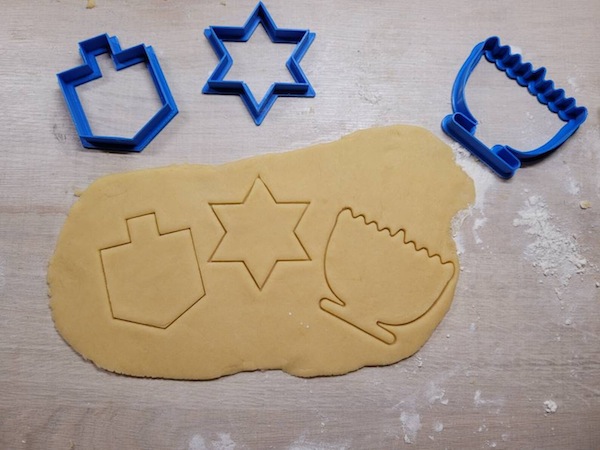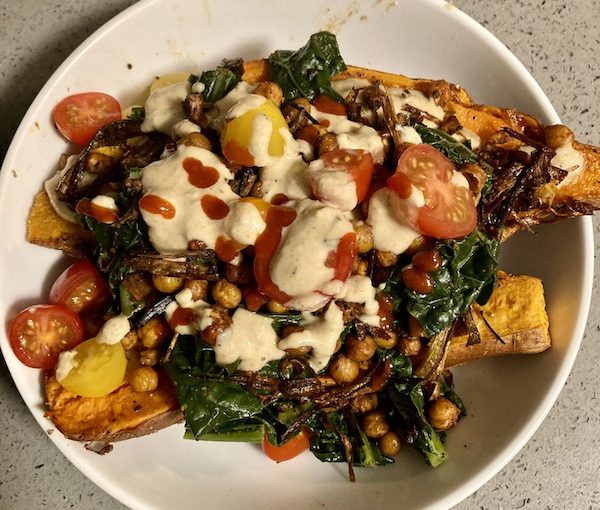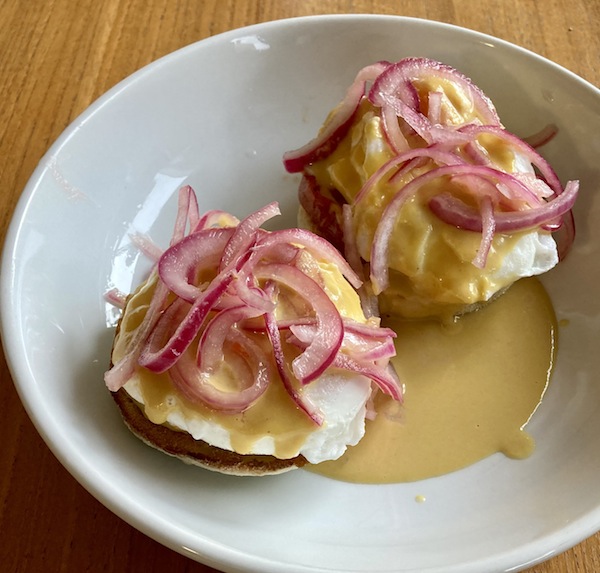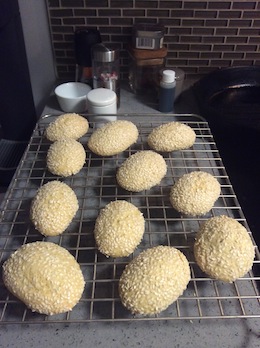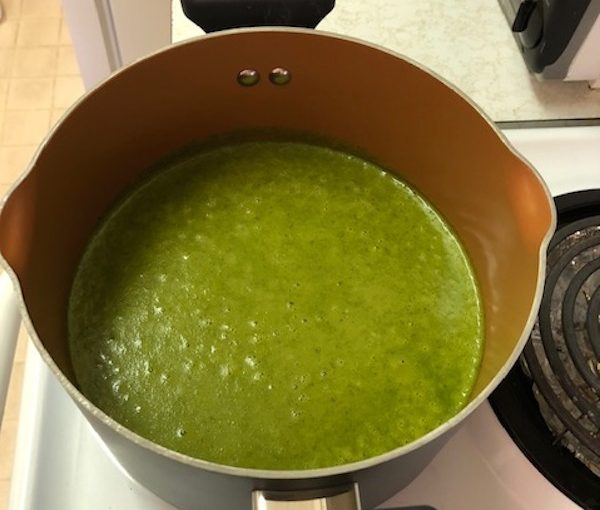Peanut cookies are so good, it’s hard to keep a batch around once you get a whiff of them. (photo by Shelley Civkin)
I’m definitely my happiest when it’s blueberry season in Vancouver. You know what I’m talking about – those huge, sweet, juicy blueberries grown in British Columbia in July and August. I can’t get enough of them, and end up putting them in salads, quinoa dishes, smoothies, breakfast foods and, of course, desserts. I often get overzealous and buy several pounds of them at once. Since there are only two of us to feed, I end up freezing loads of them, knowing that they’ll be reincarnated into something delicious in the months to come. Enter one of my faves.
LEMON BLUEBERRY CORNMEAL MUFFINS
1/2 cup butter, softened
3/4 cup sugar
2 eggs
1/2 tsp vanilla extract
1 tbsp lemon juice
1 tbsp grated lemon zest
1 1/4 cup flour
1/4 cup cornmeal
1 tsp baking powder
1/2 tsp baking soda
1/2 cup milk
3/4 cup blueberries
Preheat oven to 350ºF. Cream the butter and sugar. Add eggs, one at a time, and beat well after each addition. Beat in vanilla, lemon juice and lemon zest. The mixture may look curdled, but that’s OK.
In a separate bowl, reserve one tablespoon of flour for the berries later on. Combine remaining flour, cornmeal, baking powder and baking soda.
Add dry ingredients to butter mixture alternately with milk, beginning and ending with dry ingredients.
Toss reserved tablespoon of flour with berries and stir it into batter gently.
Pour batter into muffin tins (use cupcake liners) and bake for 25 to 30 minutes, or until golden brown on top. Test for doneness using a toothpick.
These have always been a crowd pleaser and, even though they’re nothing fancy, they’re really yummy, especially served warm – with a big glob of butter. They freeze nicely, too. Pair it with a London Fog tea and you’re all set.
My next favourite snack is not exactly fancy-shmancy, but who cares. Call me plebeian, but I’m a sucker for a peanut butter cookie. They’ve got a lot going for them besides the protein that the peanut butter provides (that’s my nutritional pronouncement and I’m sticking to it). They’re dead easy to make and everyone loves them. Well, except people who have peanut allergies. Grill your guests before serving.
PEANUT BUTTER COOKIES
1 1/2 cup all-purpose flour
1/2 cup butter, unsalted (or substitute margarine)
1 cup peanut butter
1/2 cup brown sugar
1/2 cup white sugar
1 tsp vanilla extract
1 large egg, at room temperature
3/4 tsp baking powder
Preheat oven to 350ºF. Sift flour and baking powder together then whisk to combine.
Cream butter and sugars together. Add peanut butter and mix until incorporated. Mix in egg and vanilla extract then add flour mixture and beat until incorporated.
Roll dough into one-inch balls and place on a baking sheet lined with parchment paper. Flatten cookies with a fork in a criss-cross pattern.
Bake cookies for 12 to 14 minutes, depending on whether you like them soft or crispy. Allow cookies to cool completely on the baking sheet, as they need to set before being transferred to a plate – or your mouth.
Peanut cookies are probably one of the oldest, most basic cookie recipes around, but they’re just so darn good, it’s hard to keep a batch around once you get a whiff of them. Pair them with a glass of milk, and you’ve got perfection right there in front of you.
My next cookie recipe is a bit unusual, and not terribly sweet, but, once you eat a couple of them, you’re addicted. A former colleague gave me the recipe for these tahini cookies.
TAHINI COOKIES
1 cup butter
1/2 cup white sugar
1 tsp vanilla extract
1/2 cup tahini
1 1/4 cup all-purpose flour
1/2 tsp baking powder
A couple of dashes of cinnamon (optional)
Preheat oven to 325ºF. Cream together butter and sugar until fluffy. Add vanilla and tahini and mix until well combined.
In a separate bowl, sift together the flour and baking powder, then stir it into the butter mixture. Drop tablespoon-size dough onto a baking sheet lined with parchment paper. Flatten the dough out a bit. If you make them too thick, they tend to taste doughy.
Bake until they turn golden brown, anywhere from 15 to 25 minutes. Cool on cookie sheet for 10 to 15 minutes before removing them to a wire rack or plate.
The flavour is somehow more sophisticated than, say, a chocolate chip cookie, so they might not appeal to a younger palate. Or they might, who knows. The minimal sugar, coupled with the nuttiness of the tahini, produces a seductively addictive cookie. Don’t say I didn’t warn you.
My husband recently pointed out that, since the weather has cooled, I’ve started nesting. Consequently, we’ve been eating a lot more soups, homemade challah and desserts. Not that he’s complaining. My waistline, on the other hand, is putting up a gallant (but losing) fight. I’m just plain weak-willed when it comes to homemade baked goods. I console myself with the fact that winter hibernation will be that much easier with extra poundage on board. Luckily, my new jeans have Lycra in them.
While I’ll be busy stuffing my pie-hole with cookies, I’ll be flipping through Netflix looking for the next K-drama series to binge watch. Have I mentioned that I might have a teeny-tiny addiction to K-dramas and K-romances? If you haven’t yet been introduced to Korean TV series on Netflix, do yourself a favour and try some. The acting is superb, the storylines are satisfying, and there is very little sex (unlike American TV and movies), which I find quite refreshing. The romance is chaste and sweet.
The Israeli student who I tutor English to online via Zoom introduced me to K-dramas, and the rest is history. We talk about them each week and swap suggestions for new series to watch. Not exactly what I thought I’d be talking to my student about, but it seems to work, and she gets to practise her English conversation skills. Win-win.
Allow me to recommend a few of my favourite K-dramas: Our Blues; Prison Playbook; The Good Bad Mother; Itaewon Class; It’s Okay to not be Okay; Extraordinary Attorney Woo; Hometown Cha-Cha-Cha; D.P.; King the Land; Something in the Rain; Divorce Attorney Chin; Crash Landing on You; One Spring Night; and Run On. Enjoy your fressing and viewing. You’re welcome.
Shelley Civkin, aka the Accidental Balabusta, is a happily retired librarian and communications officer. For 17 years, she wrote a weekly book review column for the Richmond Review. She’s currently a freelance writer and volunteer.


